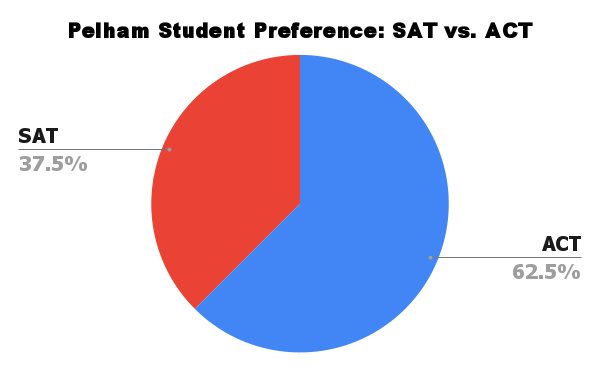Since the creation of the SAT in 1929, standardized testing has been an integral part of the American college application process. Standardized test scores are supposed to allow universities to gauge student achievement and can also inform instruction and ensure accountability for educators.
Though I understand the purpose of standardized testing, I see clear flaws within the system: The tests don’t consider a student’s individuality, assess only specific skills and measure standards that might not be the best representation of a student’s academic ability. 
As a junior, I knew I wasn’t alone in my feelings about the tests, but I also knew that I did not have a choice. So I wondered: If I must take a standardized test for college, which one should I take? The SAT or the ACT?
To answer this question, I sought the advice of other Pelham Memorial High School students.
A poll of 40 students conducted on the Pelham Examiner Instagram page shows that 63% preferred the ACT, while 37% chose the SAT.
In order to better understand these results, I did some research.
The SAT is composed of two main sections: math and English, with two subsections for each subject (typically an easier section preceding a more difficult one).
However, when the SAT became digital, it also became adaptive, meaning a student’s score in one section determines the difficulty of the following section, thus creating a different test for each student and essentially somewhat de-standardizing the most well-known standardized test in the United States.
Unlike the SAT, the ACT is split into four sections: English (grammar), math, reading and science. This gives students who struggle with math an advantage because a student’s math performance is worth only a quarter of their score on the ACT, whereas on the SAT, math performance makes up half of the total score.
The differences in test structure and subject breakdown will impact students’ scores and thus can help them decide which exam would be best for them.
This was the case for senior Grace Kiamie, who weighed the descriptions and distinctions of each standardized test before deciding to take the SAT. Unfortunately, the new online nature of the SAT created difficulties.
“Until the College Board can work out all the bugs in the new digital SAT, I would highly recommend gearing toward the ACT regardless of your junior year PSAT score,” Kiamie said. “I will say that the June SAT showed more of a resemblance to past tests which could mean a promising SAT season going into next year.”
Although the digital SAT was criticized by PMHS students and on social media, some found the paperless test to be convenient.
“I like the SAT because it’s online, which makes it not very time-consuming,” said senior Stella Winter. “It adapts to your levels in each subject and gives you questions according to your level. That way if you’re at around 450 in math generally, they might send a question that is good for a 700 math level person once, but they won’t besiege you with questions you have no chance of answering.”
Most students study for standardized tests through practice tests or books that can be found online.
On prepping for the SAT, Annika Halvorson, who graduated in June, said, “As long as you take the time to do practice tests, the question wording gets repetitive, and especially for the English section, it’s sort of based on common sense. The math section was harder because I always forgot equations I learned years before.”
After taking both exams, Kiamie said, “The ACT still is offered on paper and has had no big shifts in format over the past few years. The practice book I rented was almost identical to the actual test, revealing the ACT to be far more ‘study-able’ than the SAT, at least until [the] College Board offers better test-prep options.”
Standardized tests might not be ideal but the advice of these PMHS students should be taken seriously. Find the right test for you based on the structure and stick with it.












